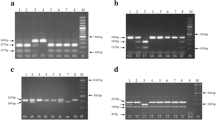Abstract
Renalase, a novel flavin adenine dinucleotide-dependent amine oxidase, is secreted by the kidney, degrades circulating catecholamines, and modulates cardiac function and systemic blood pressure (BP). Its discovery may provide novel insights into the mechanisms of BP regulation and the pathogenesis of essential hypertension (EH). We designed a two-stage case-control study to investigate whether the renalase gene harbored any genetic variants associated with EH in the northern Han Chinese population. From the International Collaborative Study of Cardiovascular Disease in Asia (InterASIA in China), 1,317 hypertensive cases and 1,269 normotensive controls were recruited. These total 2,586 subjects were taken as the main study population in this study. In stage 1, all the eight selected single nucleotide polymorphisms (SNPs) of the renalase gene were genotyped and tested within a subsample (503 cases and 490 controls) of the main study population. By single locus analyses, three SNPs, rs2576178, rs2296545, and rs2114406, showed significant associations with EH (P < 0.05). In stage 2, these three SNPs were genotyped on the remaining individuals and analyzed using all the individuals. After Bonferroni correction for multiple comparisons, the associations of rs2576178 and rs2296545 with EH were still significant in stage 2. The cases had higher frequencies of rs2576178 G allele and rs2296545 C allele than the controls (0.55 versus 0.49, P < 0.0001; 0.61 versus 0.55, P < 0.0001). Particularly, under the codominant model, the adjusted odds ratios for rs2576178 GG genotype and rs2296545 CC genotype were 1.58 (95% CI, 1.25 to 2.00; P = 0.0002) and 1.61 (95% CI, 1.26 to 2.04; P = 0.0002), respectively. We also found risk-associated haplotypes and diplotypes, which further confirmed the significant association between the renalase gene and EH. These findings may provide novel genetic susceptibility markers for EH and lead to a better understanding of EH pathophysiology. In addition, further replications in other populations and functional studies would be warranted.



Similar content being viewed by others
References
Mosterd A, D’Agostino RB, Silbershatz H, Sytkowski PA, Kannel WB, Grobbee DE, Levy D (1999) Trends in the prevalence of hypertension, antihypertensive therapy, and left ventricular hypertrophy from 1950 to 1989. N Engl J Med 340:1221–1227
Warlow CP (1998) Epidemiology of stroke. Lancet 352(Suppl 3):SIII1–SIII4
Lifton RP (1996) Molecular genetics of human blood pressure variation. Science 272:676–680
Tanira MO, Al Balushi KA (2005) Genetic variations related to hypertension: a review. J Hum Hypertens 19:7–19
Gimenez-Roqueplo AP, Jeunemaitre X (2003) Genetics and essential hypertension: candidate genes or screening of the whole genome? Arch Mal Coeur Vaiss 96:1089–1095
Naber CK, Siffert W (2004) Genetics of human arterial hypertension. Minerva Med 95:347–356
Xu J, Li G, Wang P, Velazquez H, Yao X, Li Y, Wu Y, Peixoto A, Crowley S, Desir GV (2005) Renalase is a novel, soluble monoamine oxidase that regulates cardiac function and blood pressure. J Clin Invest 115:1275–1280
Luft FC (2005) Renalase, a catecholamine-metabolizing hormone from the kidney. Cell Metab 1:358–360
Jose PA, Eisner GM, Felder RA (1998) Renal dopamine receptors in health and hypertension. Pharmacol Ther 80:149–182
Jose PA, Eisner GM, Felder RA (2002) Role of dopamine receptors in the kidney in the regulation of blood pressure. Curr Opin Nephrol Hypertens 11:87–92
Aperia AC (2000) Intrarenal dopamine: a key signal in the interactive regulation of sodium metabolism. Annu Rev Physiol 62:621–647
Doris PA (2000) Renal proximal tubule sodium transport and genetic mechanisms of essential hypertension. J Hypertens 18:509–519
Satagopan JM, Elston RC (2003) Optimal two-stage genotyping in population-based association studies. Genet Epidemiol 25:149–157
Satagopan JM, Venkatraman ES, Begg CB (2004) Two-stage designs for gene-disease association studies with sample size constraints. Biometrics 60:589–597
Gu D, Reynolds K, Wu X, Chen J, Duan X, Reynolds RF, Whelton PK, He J (2005) Prevalence of the metabolic syndrome and overweight among adults in China. Lancet 365:1398–1405
Gu D, Reynolds K, Wu X, Chen J, Duan X, Muntner P, Huang G, Reynolds RF, Su S, Whelton PK, He J (2002) Prevalence, awareness, treatment, and control of hypertension in China. Hypertension 40:920–927
Perloff D, Grim C, Flack J, Frohlich ED, Hill M, McDonald M, Morgenstern BZ (1993) Human blood pressure determination by sphygmomanometry. Circulation 88:2460–2470
Schaid DJ, Rowland CM, Tines DE, Jacobson RM, Poland GA (2002) Score tests for association between traits and haplotypes when linkage phase is ambiguous. Am J Hum Genet 70:425–434
Lake SL, Lyon H, Tantisira K, Silverman EK, Weiss ST, Laird NM, Schaid DJ (2003) Estimation and tests of haplotype-environment interaction when linkage phase is ambiguous. Hum Hered 55:56–65
Guo SW, Thompson EA (1992) Performing the exact test of Hardy–Weinberg proportion for multiple alleles. Biometrics 48:361–372
Barrett JC, Fry B, Maller J, Daly MJ (2005) Haploview: analysis and visualization of LD and haplotype maps. Bioinformatics 21:263–265
Gu D, Su S, Ge D, Chen S, Huang J, Li B, Chen R, Qiang B (2006) Association study with 33 single-nucleotide polymorphisms in 11 candidate genes for hypertension in Chinese. Hypertension 47:1147–1154
Hattersley AT, McCarthy MI (2005) What makes a good genetic association study? Lancet 366:1315–1323
Shiffman D, Ellis SG, Rowland CM, Malloy MJ, Luke MM, Iakoubova OA, Pullinger CR, Cassano J, Aouizerat BE, Fenwick RG, Reitz RE, Catanese JJ, Leong DU, Zellner C, Sninsky JJ, Topol EJ, Devlin JJ, Kane JP (2005) Identification of four gene variants associated with myocardial infarction. Am J Hum Genet 77:596–605
Acknowledgment
This work was supported by the National Basic Research Program of China (Grant No. 2006CB503805) and the Beijing Natural Science Foundation (Grant No. 7061006).
Author information
Authors and Affiliations
Corresponding author
Rights and permissions
About this article
Cite this article
Zhao, Q., Fan, Z., He, J. et al. Renalase gene is a novel susceptibility gene for essential hypertension: a two-stage association study in northern Han Chinese population. J Mol Med 85, 877–885 (2007). https://doi.org/10.1007/s00109-006-0151-4
Received:
Revised:
Accepted:
Published:
Issue Date:
DOI: https://doi.org/10.1007/s00109-006-0151-4



